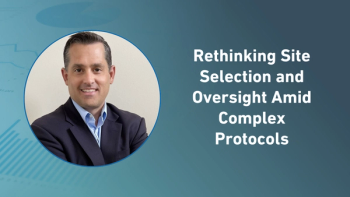
How to Address—and Overcome—Operational Challenges in Master Protocol Studies
Trials that address multiple questions simultaneously using a master protocol can be operationally complicated. These complexities can be managed, even in studies used to support a marketing application.
The critical need for COVID-19 therapeutics has helped to underscore an ongoing urgent need for more innovative clinical designs.
According to Operation Warp Speed’s Janet Woodcock, the COVID-19 pandemic has put a spotlight on long-standing inefficiencies in the U.S. clinical trials enterprise.1 Early in the pandemic, Woodcock, then director of the U.S. Food and Drug Administration’s (FDA) Center for Drug Evaluation and Research (CDER), warned that clinical trial apparatus could be overwhelmed if master protocols, other platform approaches and adaptive designs were not adopted to more efficiently study potential COVID-19 treatments and vaccines.2
Master protocols, especially platform trials, have recently garnered attention in COVID-19 studies. One example we’ve been supporting is NIH’s
However, across the broader R&D pipeline, master protocols continue to be underutilized.
This is a missed opportunity. In 2018, FDA drafted guidance, Master Protocols: Efficient Clinical Trial Design Strategies to Expedite Development of Oncology Drugs and Biologics. The guidance reads: “In contrast to traditional trial designs, where a single drug is tested in a single disease population in one clinical trial, master protocols use a single infrastructure, trial design, and protocol to simultaneously evaluate multiple drugs and/or disease populations in multiple substudies, allowing for efficient and accelerated drug development.”3
Depending on the statistical design, master protocols can offer significant benefits:
- Increased speed and quality of decisions: Accelerating successful investigations and discontinuing failing interventions sooner
- Reduced costs: Sharing trial infrastructure, design and protocol (e.g., cost efficiencies from shared site recruitment, investigational sites, administration, control arms, systems, overhead, etc.). Deloitte estimates master protocols reduce costs by an estimated 13-18%4
- Shortened timeline: Deloitte estimates master protocols reduce timelines by 12-15%4
- Streamlined regulatory submission, review and amendment processes: Efficiencies can be gained from a single master protocol submission and shared regulatory, Institutional Review Board (IRB)/Ethics Committee (EC) and review committees
- Patient allocation: Patients can be screened and allocated to the most appropriate substudies with applicable treatments
Though the potential benefits are large, so, too, are the operational considerations. This is particularly true for umbrella and platform studies, which are often large, complex, resource-intensive, competitive and constantly evolving. These studies may involve multiple life sciences companies and investigative agents both as monotherapy and in combination. Operational activity is not sequential, but instead happens concurrently. For example, it is common for a platform study to have some substudies in startup mode, some actively enrolling and some closed out.
Five key success factors
Studies that use master protocols are not “business as usual.” In our experience, these operational guidelines can help smooth the way.
1. Leadership presents a clear and consistent core goal/philosophy to guide decision-making. When embarking on a study that uses a master protocol, it’s important to articulate a clear vision and philosophy. This can become particularly critical when there are competing interests (e.g., the needs of different partners or different substudies). Every decision, in turn, must be grounded in your core goal/philosophy. For example, if patient centricity is identified as the core goal, you might pressure test proposed changes by asking: “How will this change help the patient?”
2. Regulatory engagement (early and often). Sponsors may worry about diverging from traditional regulatory pathways. Our experience is that regulatory agencies encourage master protocols and welcome dialogue with sponsors pursuing their use. Early engagement with regulatory agencies is critical. FDA, for example, strongly encourages sponsors to discuss plans to develop drugs under a master protocol with the clinical review division early in the program to obtain feedback.
FDA also can serve as a valuable source to provide feedback on emerging issues. In one complex umbrella trial studying more than 10 investigational compounds, for example, the principal investigators (PIs) became overwhelmed by cross reports. A consultation with FDA minimized cross-reporting requirements by excluding expedited reporting for events that occurred as natural history of disease.
3. Upfront and ongoing planning in the face of near constant change. De-risking the complexity inherent in a master protocol structure—while operating in a state of constant change—demands rigorous planning. This effort may start with the development of an integrated quality and risk management plan (IQRMP) that defines answers about the who, what, where, when, why and how in relation to an evolving protocol. The IQRMP defines the actions each functional group and party will take to proactively identify, assess and manage risk throughout the life of the master protocol and substudies. Built with the understanding that it’s impossible to foresee all the risks at study initiation, an IQRMP should incorporate flexibility to adapt to the speed and frequency of the changes associated with master protocols. Rather than trying to predict a fixed future, the IQRMP serves as a tool to understand the data that will be available at each point to make real-time decisions as the study evolves.
Given the inevitability of a constantly changing environment, it’s also important to plan and budget for ongoing adjustments in study documents including the protocol, Informed Consent Form (ICF), contract, budget and clinical supplies. Effective communication and clear processes are also essential to guard against site and team fatigue. Planning out the smallest details, for example, accurately labelling lab kits to clearly differentiate which treatment arm/cohort they belong to, can go a long way to reduce the risk of errors.
4. Flexible and scalable systems and technology capable of accommodating a master protocol. Using a shared infrastructure and study database across substudies can be an efficiency—and a challenge. Systems must be capable of both scaling across and adapting to the evolving—and differing—needs of the master protocol and substudies. At the same time, more frequent protocol changes demand frequent system and interface updates.
One of the primary key success factors for master protocol studies is the real-time collection and analysis of data with high quality to enable real-time decision making. This is extremely challenging in a fast-paced and constantly evolving study with complex protocol design.
Moreover, the pace of change can be exponential. In one umbrella study, for example, we expanded a six-cohort study into a 25-cohort study in response to signals seen as we expanded into Phase II. While this study ultimately accomplished under one umbrella what may have taken 10 to 15 traditionalstudies to achieve, it required eight substantial protocol amendments and 25 database modifications. Although these changes were strategically grouped to minimize site fatigue, they would have still strained most systems. Long-term programmatic solutions capable of analyzing enormous data sets—and an anticipation of incremental study expansion—built into systems from the onset can help accommodate the unique demands of master protocol trials.
Innovative technology tools also help smooth protocol amendment implementation by capturing and transferring key protocol data elements, streamlining data flow and speeding up protocol amendment process. Consider, for example:
A simulation tool that models different scenarios including the study endpoints, target population, sample size and power determination to help determine protocol design changes and drive the protocol amendment
- A simulation tool that models different scenarios including the study endpoints, target population, sample size and power determination to help determine protocol design changes and drive the protocol amendment
- A study planning tool that models the protocol change (e.g., adding or removing cohorts, change of sample size, interim analysis, eligibility criteria) and generates different study strategy scenarios to help facilitate cohort management and the implementation of downstream operational activities.
- An orchestrated workflow with an integrated system infrastructure to help synchronize the changes in various systems, streamline the dataflow, and reduce the possibility of errors due to systems not being updated at the same time.
Interoperability between systems also should be assessed. Traditionally, the downstream work activities conducted by parties in a trial (e.g., regulatory affairs, ethics committees, IRBs, sponsors, CROs, vendors and sites) are carried out using different processes and systems. A lack of interoperability might be manageable in a single traditional study, but when multiplied by five, 10 or more substudies can threaten to overwhelm a trial. Technology innovations potentially can help break the cross-organizational barriers and create efficiency and synergy. Figure 1 portrays just one example.
Figure 1. Integrated communications platform across organizations in a basket trial
5. An open, adaptable mindset. Teams working on master protocols must be prepared to operate in an environment characterized by constant change. Using a master protocol, teams are given the flexibility to take proactive action midstream to add or remove indication cohorts and drug combinations, while conducting other investigations in response to findings without having to go back to the drawing board to write a new protocol and set up additional studies.
A team also must be prepared to take reactive action, managing the magnitude of the cascade of activities that the addition and removal of substudies can cause. A team that balances master protocol and therapeutic experience with an open and adaptable mindset is an ideal mix.
Flexibility in vendors is equally important. Are the vendors willing to invest in making their processes more flexible? “Our SOP doesn’t allow that,” is not the response you want to hear from a vendor as you brainstorm solutions for emerging issues. Master protocol trials demand an open collaborative process in which participants bring their most innovative solutions to the table.
The pathway to adoption
Regulatory authorities and forward-thinking clinical trial teams are increasingly embracing a range of advanced clinical trial designs—as we have seen particularly in COVID-19 and oncology studies. Unfortunately, adoption of master protocols across the broader R&D pipeline has been, at least in part, hampered by deeply entrenched habits and mindsets.
The key to adoption of master protocols is to keep an open mind while, at the same time, analyzing the complexity and potential benefits for your specific clinical trial. While the scientific and operational challenges of clinical trials that use master protocols are real, our experiences have shown again and again that the efficiencies and benefits far outweigh the complexities.
In fact, once you have experienced a master protocol’s innate adaptability, enhanced decision-making, and expedited development, you may find that a return to traditional methods might strike you as inflexible, inefficient, and slow.
Dirk Reitsma, MD, is Vice President, Oncology, Global Product Development; Rachael Song is Associate Director, Early Development, Hematology/Oncology Therapeutic Unit; Kent Buhler is Senior Director,Project Management; Melanie Owen is Senior Director, Early Development, Hematology/Oncology Therapeutic Unit; and Song Wang is Statistical Science Director, Biostatistics, all with PPD.
References
- COVID-19 Should Force ‘Soul Searching’ Over Fragmented US Clinical Trials System, Woodcock Says. Pink Sheet. Published October 8, 2020. Accessed October 20, 2020. https://pink.pharmaintelligence.informa.com/PS143029/COVID19-Should-Force-Soul-Searching-Over-Fragmented-US-Clinical-Trials-System-Woodcock-Says
- Woodcock Warns Research Apparatus Could Be Overwhelmed If Coronavirus Trials Don’t Use Master Protocols. Pink Sheet. Published April 28, 2020. Accessed January 15, 2021. https://pink.pharmaintelligence.informa.com/PS142080/Woodcock-Warns-Research-Apparatus-Could-Be-Overwhelmed-If-Coronavirus-Trials-Dont-Use-Master-Protocols
- Food and Drug Administration. Master protocols: efficient clinical trial design strategies to expedite development of oncology drugs and biologics guidance for industry. Published 2018. Accessed July 25, 2020. https://www.fda.gov/media/120721/download
- Lesser N, Naaz B. Shifting the drug development paradigm. Deloitte. Published 2018. https://www2.deloitte.com/content/dam/insights/us/articles/4509_Master-protocols/DI_Master-protocols.pdf
Newsletter
Stay current in clinical research with Applied Clinical Trials, providing expert insights, regulatory updates, and practical strategies for successful clinical trial design and execution.




